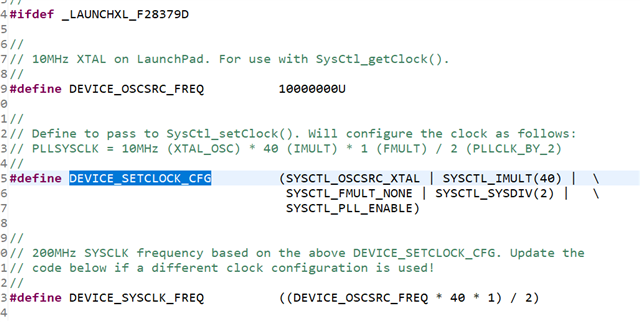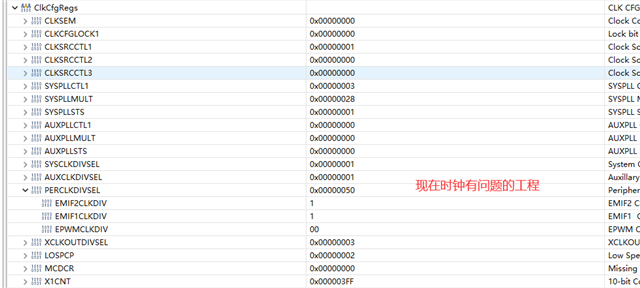#include "driverlib.h"
#include "device.h"
uint32_t clock1=0,lowclock1=0;
void main(void)
{
//
// Disable the watchdog
//
SysCtl_disableWatchdog();
#ifdef CMDTOOL
CMD_init();
#endif
#ifdef _FLASH
#ifndef CMDTOOL
//
// Copy time critical code and flash setup code to RAM. This includes the
// following functions: InitFlash();
//
// The RamfuncsLoadStart, RamfuncsLoadSize, and RamfuncsRunStart symbols
// are created by the linker. Refer to the device .cmd file.
//
memcpy(&RamfuncsRunStart, &RamfuncsLoadStart, (size_t)&RamfuncsLoadSize);
#endif
//
// Call Flash Initialization to setup flash waitstates. This function must
// reside in RAM.
//
Flash_initModule(FLASH0CTRL_BASE, FLASH0ECC_BASE, DEVICE_FLASH_WAITSTATES);
#endif
#ifdef CPU1
//
// Configure Analog Trim in case of untrimmed or TMX sample
//
// if((SysCtl_getDeviceParametric(SYSCTL_DEVICE_QUAL) == 0x0U) &&
// (HWREGH(ANALOGSUBSYS_BASE + ASYSCTL_O_ANAREFTRIMA) == 0x0U))
// {
// Device_configureTMXAnalogTrim();
// }
//
// Set up PLL control and clock dividers
//
SysCtl_setClock(DEVICE_SETCLOCK_CFG);
//
// Make sure the LSPCLK divider is set to the default (divide by 4)
//
SysCtl_setLowSpeedClock(SYSCTL_LSPCLK_PRESCALE_4);
//
// These asserts will check that the #defines for the clock rates in
// device.h match the actual rates that have been configured. If they do
// not match, check that the calculations of DEVICE_SYSCLK_FREQ and
// DEVICE_LSPCLK_FREQ are accurate. Some examples will not perform as
// expected if these are not correct.
//
clock1=SysCtl_getClock(DEVICE_OSCSRC_FREQ);
lowclock1=SysCtl_getLowSpeedClock(DEVICE_OSCSRC_FREQ);
ASSERT(SysCtl_getClock(DEVICE_OSCSRC_FREQ) == DEVICE_SYSCLK_FREQ);
ASSERT(SysCtl_getLowSpeedClock(DEVICE_OSCSRC_FREQ) == DEVICE_LSPCLK_FREQ);
#ifndef _FLASH
//
// Call Device_cal function when run using debugger
// This function is called as part of the Boot code. The function is called
// in the Device_init function since during debug time resets, the boot code
// will not be executed and the gel script will reinitialize all the
// registers and the calibrated values will be lost.
// Sysctl_deviceCal is a wrapper function for Device_Cal
//
// SysCtl_deviceCal();
#endif
#endif
//
// Turn on all peripherals
//
// Device_enableAllPeripherals();
}


移植universalmotor_lab 到 F28379D平台上,系统时钟出现了问题,目标是配置系统时钟为200M ,低速时钟为50M,
clock1=SysCtl_getClock(DEVICE_OSCSRC_FREQ);
lowclock1=SysCtl_getLowSpeedClock(DEVICE_OSCSRC_FREQ);
但是现在用读到的时钟全部是400M 。同样的代码在其他工程上是正确的。请问这个是为什么?



